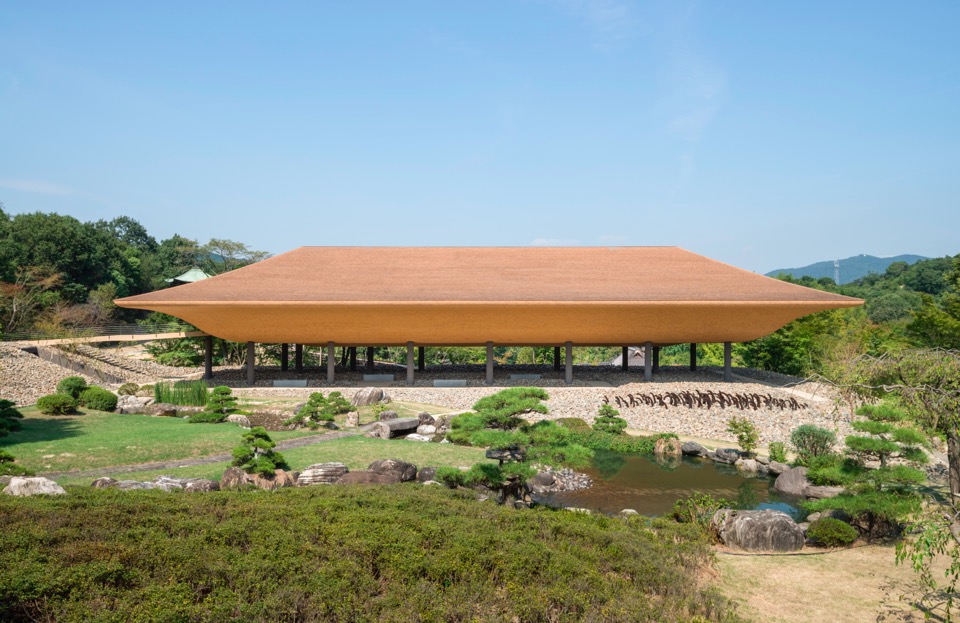洸庭

2016年、広島県福山の「神勝寺 禅と庭のミュージアム」内に新たにつくられた、彫刻家・名和晃平氏とSANDWICHの設計によるアートパビリオン《洸庭(こうてい)》。その内部には、WOWと名和晃平のコラボレーションによるインスタレーション作品が広がる。 「小さな入り口から舟のなかへ入ると、暗がりに広がる海原に出会う。その表面は静かに波立ち、静寂と闇のなか「波」に反射する「光」と対峙することで思索の時間を過ごすことができる。不思議なことに波間にたゆたう光をじっと眺めていると、視覚だけでなく聴覚までもが研ぎ澄まされる。現代人はさまざまな映像メディアによって、毎日のように情報のシャワーを浴び続けている。商業エリアに溢れる光や映像は短時間で大勢に情報を伝え、消費者の欲望を掻き立てることに特化したものが多いが、そういうものから離れた静かな知覚体験が、ダイレクトにその人の感性に響くことがある。もちろん、瞑想のための時間/空間とはいえ、拝観者それぞれの感じ方、受け止め方があるだろう。プランニングの段階から、「禅」をそのまま表現するつもりはなかったが、その場に訪れたことが記憶に残り、現代における禅的な感性、哲学とは何かということをふと考えるきっかけになるなら、それに越したことはない。」 (名和晃平「山あいに浮かぶ舟のような建築」、『新建築』2016年12月号、pp.74-85、新建築社記事より) 映像は「波」によって「光」に還元される。映像の解像度の進化は留まる事なく進歩し、8K、16Kとこの先も進んでいくだろう。しかしこの作品においては、どんなに高解像度な映像であっても「光」に還元され、未来においても作品性は全く移ろう事なく、存在し続けるだろう。映像という移ろいやすいメディウムが、「光」にまで還元されて初めて、現象の再現性、物語性、そして永続性を持ち得えた。これは映像表現の本質的変革であり、変革は瞑想の苗床である静寂と闇の中から生まれた。 (田崎佑樹|WOWコンセプター、中路琢磨|WOWクリエイティブ・ディレクター)
今年の春にはWOWと音楽家の原摩利彦氏により、《洸庭》内部に環境音を加え、光と時と空間の一体感がより高まりました。アップデートした《洸庭》もぜひこの機会にお楽しみください。 ▶Official websiteStaff KOHTEI Project Members Planning:Shinshoji temple and Kohei Nawa | SANDWICH Project management:Toshiko Ferrier of Office Ferrier Installation:Kohei Nawa | SANDWICH with WOW Sound:Marihiko Hara Cooperation:NICCON and SUPER FACTORY WOW Staff Conceptor:Yuki Tazaki Creative Director:Takuma Nakazi Programmer:Tomohiro Nagasaki, Shunsaku Ishinabe Sound Engineer:Hikari Mutaguchi (White Light)
「洸庭」図録刊行
洸庭の建築と内部のインスタレーション、周囲の環境を含めた「作品」を、さまざまな視点でとらえた図録「『洸庭』名和晃平|SANDWICH」が完成。建築史家/建築批評家・五十嵐太郎氏の論考、写真家・表恒匡氏による「洸庭」を追体験する写真とGottinghamによるマテリアルの特徴をとらえたイメージ、名和氏のコンセプトテキスト、アートパビリオンに関わる職人やクリエイターの制作過程がSANDWICHによる図面とともにまとめられています。 この美しい図録は、アートパビリオンの多様な体験を伝え、作品をあらためて感じ、読み解いていくためのきっかけとなるべく制作されました。また、図録刊行を記念して、五十嵐氏と名和氏の対談イベントも予定。図録・イベント詳細はコチラから。
Other News
Subscribe to our newsletter
ニュースレター「WOW magazine」を、毎月1~2回配信しています。 ご希望の方は、下記フォームにメールアドレスをご入力ください。
